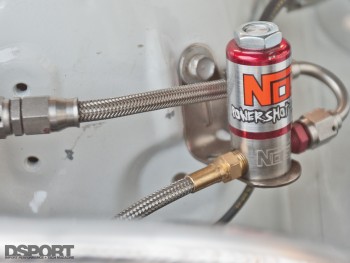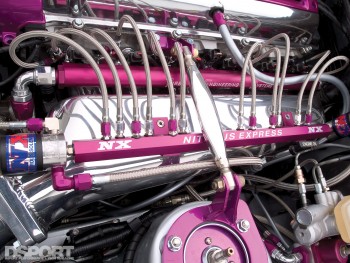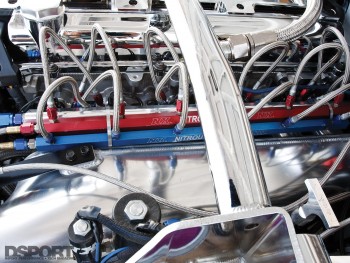Instant Boost
 While turbochargers are the ultimate power adder in terms of peak horsepower output, big turbos can often significantly affect throttle response. Big turbos tend to experience “turbo lag” as the time required to “spool” the turbocharger into producing peak boost can be quite excessive. In many cases, big turbos affect the useable powerband of the engine as appreciable power is sometimes not available at the lower engine speeds. Adding a nitrous-oxide system to a turbocharged vehicle can drastically change the engine’s character and powerband. With the activation of the nitrous-oxide system, it is not uncommon for the boost pressure to reach its peak in an instant. An incredible improvement in boost response can result even with conservative jetting of the nitrous-oxide system. If just an improvement in boost response is desired, a pressure switch can be incorporated to deactivate the nitrous-oxide system once the desired boost pressure is reached. This configuration also has the added benefit of conserving nitrous-oxide, allowing more time before bottle refills.
While turbochargers are the ultimate power adder in terms of peak horsepower output, big turbos can often significantly affect throttle response. Big turbos tend to experience “turbo lag” as the time required to “spool” the turbocharger into producing peak boost can be quite excessive. In many cases, big turbos affect the useable powerband of the engine as appreciable power is sometimes not available at the lower engine speeds. Adding a nitrous-oxide system to a turbocharged vehicle can drastically change the engine’s character and powerband. With the activation of the nitrous-oxide system, it is not uncommon for the boost pressure to reach its peak in an instant. An incredible improvement in boost response can result even with conservative jetting of the nitrous-oxide system. If just an improvement in boost response is desired, a pressure switch can be incorporated to deactivate the nitrous-oxide system once the desired boost pressure is reached. This configuration also has the added benefit of conserving nitrous-oxide, allowing more time before bottle refills.
The Basic System
A bottle, high-pressure lines, solenoids, jets and nozzles are included in all nitrous-oxide systems. The nitrous- oxide bottle usually holds 10 pounds of nitrous oxide and the trunk is the most popular mounting location. A high-pressure line carries the nitrous oxide forward to the solenoid. The solenoid is an electronically-controlled valve. When a signal of 12 volts is sent to the solenoid, it opens and sends nitrous oxide to the nozzle(s) placed on the intake tract of the engine. At the same time that nitrous oxide is injected into the engine, the nitrous-oxide system will (by some means) add additional fuel into the engine.
The “Wet” System
The original and simplest method of injecting the fuel is by using a second solenoid and a fuel nozzle setup. This configuration is often referred to as a “wet” system. With a wet configuration, the fuel is injected at a pressure of anywhere from 6 to 60 psi, while the nitrous oxide is simultaneously injected at a pressure of 700-1200 psi.
Wet systems are generally set up in one of the three following fuel-delivery configurations for electronic fuel injection (EFI) applications: high-pressure, single-nozzle (HPSN); high-pressure direct-port (HPDP); or low-pressure direct-port (LPDP). The high-pressure, single-nozzle setup is the most common among wet-system manufacturers. In this HPSN configuration, fuel is injected before the intake manifold (often times through a combination nozzle with the nitrous oxide). The advantages of this configuration are that it’s the easiest to install, jet changes are made in a fraction of the time compared to a direct-port system, and every cylinder receives the same ratio of nitrous oxide to fuel (although the amount received by each cylinder can vary depending on the intake manifold design). To ensure that each cylinder receives an equal amount of nitrous-oxide and fuel regardless of the intake manifold design, some tuners prefer a direct-port system. In these systems, the nitrous and fuel nozzles are positioned directly in front of each intake port. Comparing direct-port wet systems, the configurations between the HPDP and LPDP systems are identical with the exception of the fuel pressure being sent to the fuel solenoid. High-pressure, direct-port systems feed the fuel solenoid with fuel at 40-45psi in most cases, whereas a low-pressure, direct-port system employs an additional fuel pressure regulator or a secondary fuel system that supplies the fuel at around 6psi. Due to the drastic differences in supply pressures, the size of the fuel jet is significantly smaller on high-pressure, direct-port setups. A number of nitrous-oxide system manufacturers feel that small fuel jets can become a big area of concern, as small particles can choke or completely block the flow of fuel through the small orifice. If the fuel jet becomes clogged, the ratio of nitrous-oxide-to-fuel is upset and a fuel-lean condition occurs. This can result in detonation and severe engine damage. As a result, many nitrous-oxide system manufacturers prefer to offer low-pressure, direct-port systems so that fuel jets with larger orifices can be used or they place a limiting jet ahead of the jets at each nozzle.
“Dry” Systems
The term “Dry” nitrous-oxide system was coined in reference to nitrous-oxide systems that used the factory injectors to supply the additional fuel into the engine. The original dry systems designed by Nitrous Oxide Systems send a pressure signal to the factory fuel pressure regulator to increase the rail pressure. This increase in fuel pressure allows the injectors to supply more fuel for the added nitrous oxide. This is the strategy employed by most “dry” systems.
All dry systems are limited in the amount of power that they can produce safely by the factory fuel pump and injectors. With typical dry systems, the fuel pressure being supplied to the injectors is increased when the nitrous-oxide system is activated. In turn, the fuel pump is required to work harder to supply fuel at a higher operating pressure. With fuel pumps, the flow potential of the pump is always reduced as operating pressure increases. As a result, the fuel pump is generally the limiting factor on fuel supply and power output with the conventional dry-manifold strategy. In most cases, it’s cheap insurance to upgrade the fuel pump to ensure that a steady supply of fuel is available. Always remember that when any single component in the fuel system is maxed, the fuel system as a whole reaches its limit. In essence, the chain becomes only as strong as the weakest link.




